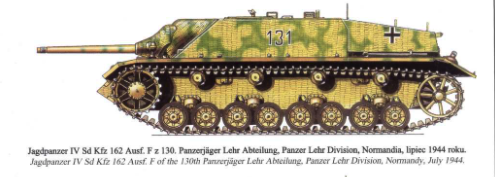Description
Unteroffizier Willi Zabel
Zabel was born on the 13th of August 1918 into a protestant family in Kassel.
Zables Soldbuch was issued in April 1940 with a Schützen Replacement unit.
Frontline Units
Schützen Regiment 6
Under the 7th Panzer Division, Zabel was wounded in Russia with the Regiment.
Panzer Grenadier Regiment 59
Under the 20th Panzer Division in Russia, Zabel was shot this time with an infantry bullet.
Panzer Jäger Lehr Abteilung 130
Zabel served with: – Stabs Kompanie (Later in Versorgungs Kompanie)
Pz.Jg.Lehr-Abt. 130 was armed with31 Jagdpanzer Model IV distributed among Stab (3), 1. and 2. Kp. (14 each) but by 1.6.1944 4 were with the Stab while 1., 2. and 3. Kp. each had 9 plus 4 7,5 cm Pak 40 mot.Z.
According to the Soldbuch, Zabel was with the Abteilung from April 1944 til his capture in 1945.
On D-Day itself, the division was near Paris under the control of the I SS Panzer Corps as part of the OKW (Oberkommando der Wehrmacht – High Command of the German Armed Forces) armoured reserve. The division was immediately ordered forward but in doing so, suffered delays and equipment losses (mainly soft-skinned vehicles) due to the Allied air superiority over Normandy. Entering the line next to the 12th SS Panzer Division ‘Hitlerjugend’ near Caen, it fought several British and Canadian attacks to a standstill, even managing (with elements of the 2nd Panzer Division and 101st SS Heavy Panzer Battalion) to retake the village of Villiers-Bocage in a counterattack after it was captured by the British 22nd Armoured Brigade. This battle also saw the famous action by panzer ace SS Obersturmführer Michael Wittman.
The division was then relieved by the 276th Infantry Division and on 7 July transferred to the LXXXIV Corps opposite US forces as they prepared to breakout as part of Operation Cobra, which was launched on 25 July. It was immediately preceded by an aerial bombardment from 1,500 Allied bombers and although this caused a lot of disruption and badly hit morale, there is still debate as to the actual number of casualties and equipment losses this caused. Nevertheless, despite suffering from both personnel and equipment attrition, the division managed to hold the advance of the entire US VII Corps to less than two miles on the 25 July. By the beginning of August, the division was down to around 11,018 personnel and thirty-three operational tanks and assault guns, with another forty-four under repair but following the encirclement of German forces at Falaise, the division was split into three Kampfgruppen (battlegroups) who fought their way out to re-join German forces retreating eastwards, eventually reuniting at Senlis. It then retreated into the West Wall covering Bitburg, took part in the early battles for the Siegfried Line in Luxembourg with the LXXXI Corps before withdrawing to the Saar region and then Paderborn to be rebuilt and refitted under Sixth Panzer Army. It was then transferred to the First Army and helped prevent the collapse of Army Group G in November 1944 by counter attacking US forces advancing on the Saverne Gap.
The division was then placed under the control of the XXXXVII Panzer Corps, part of the Fifth Panzer Army under General der Panzertruppen Hasso von Manteuffel which was due to take part in Operation Wacht am Rhein, more commonly known as the ‘Battle of the Bulge’. However, the premature commitment of several units (including Panzer Lehr) in order to stem the advance of US forces just weeks before, led to the operation being postponed while the units involved were brought back up to strength. Even so, Panzer Lehr was still under strength (twenty-seven PzKw IV, thirty Panthers and twenty Jagdpanzer IV/70s) by the time the operation commenced on 16 December and so was reinforced by two tank destroyer battalions and an assault gun brigade. The 26th Volksgrenadier Division was meant to clear the way for the division but became bogged down. Panzer Lehr, which had been part of the Fifth Panzer Army’s reserve (along with the Führer Begleit Brigade), entered the line where it besieged Bastogne (held by the US 101st Airborne Division) but could not take the town. When the offensive failed, the division relocated to the Netherlands and fought in the Battle for the Maas Line and then moved south to try to eliminate the American bridgehead at Remagen in early March 1945. By this time the division was merely a burnt out shell of its former self, being only a large battalion battle group in size. It then retreated into the Ruhr Pocket, surrendering to the US 99th Infantry Division on 15 April 1945.
Wounded
31.8.1941 – Grenader Splinter left side
4.1.1943 – Shot with a Infantry bullet
Awards
3.1.1941 – Black Wounds Badge
22.12.1941 – Tank Assault Badge in Bronze
8. 1943 – Sports Badge in Bronze
1. 1945- War Merit Cross with Swords
Equipment
Zabel had a model 35 Pistol
Comments
An interesting Soldbuch to a Normandy/Ardennes fighter, highly desirable unit, so much information online about this division on the web. Very nice picture taken with Zabel in Panzer Black uniform. Sadly, Zabel died as a POW in France September 1945 in Mont de Huisnes France when he is now buried. Moreover, the damage on the Soldbuch would indicate it was burned, although the information was wrote around the burn which could indicate that the damage was wartime.























